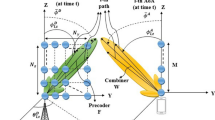Abstract
In the interference mitigation context, it has been shown by simulations in Fety et al. (International symposium on wireless communication systems, pp 241–245, 2012), the outperformance of the coefficient constraints (CC) versus the power constraint on the channel impulse response, in terms of BER about 1–3 dB. However, no theoretical justification has been introduced. In this paper, we have proved theoretically this result. Moreover, we have investigated an interesting issue of the CC constraint concerning the choice of the coefficient position; we have given a full theoretical framework analysis about this feature. Two substantial propositions have been introduced to this end. Theoretical results were validated by simulations.









Similar content being viewed by others
References
Fety, L., Maoudj, R., Terre, M., Martinod, L., & Mege, P. (2012, August). Reduced rank spatial filter for interference cancellation. In International symposium on wireless communication systems, pp. 241–245.
Andrews, J. G. (2005). Interference cancellation for cellular systems: A contemporary overview. IEEE Wireless Communications Magazine, 12, 19–29.
Paulraj, A., Naber, R., & Gore, D. (2003). Introduction to space–time wireless communications. Cambridge: Cambridge University Press.
Foschini, G. J., & Gans, M. J. (1998). On limits of wireless communications in a fading environment when using multiple antennas. Wireless Personal Communication, 6, 311–335.
Daleh, M., Daleh, M.A., & Verghese, G. (2000). Lectures on dynamic systems and control. Dept. of Elec. Eng. and Comp. Sci., Mass. Inst. Tech.
Higham, N. J. (1987). A survey of condition number estimation for triangular matrices. SIAM Review, 29(4), 575–596.
Lagunas, M. A., Vidal, J., & Pérez Neira, A. I. (2000). Joint array combining and MLSE for single-user receivers in multipath Gaussian multiuser channels. IEEE Journal on Selected Areas in Communication, 18(11), 2252–2259.
Pérez Neira, A. I., & Mestre, X. (2002, May). A comparative performance study of different space-frequency filters for OFDM. In Proceedings of the IEEE international conference on acoustics, speech, and signal processing.
Vidal, J., Cabrera, M., & Augustin, A. (2000). Full exploitation of diversity in space–time MMSE receivers. In 52nd Vehicular technology conference, IEEE VTS-Fall VTC 2000, Vol. 5, pp. 2497–2502.
Maoudj, R., & Terre, M. (2012, September). Post-combiner for interference cancellation algorithm. In International conference on software, telecommunications and computer networks.
Edelman, A. (1988). Eigenvalues and condition number of random matrices. SIAM Journal on Matrix Analysis and Applications, 9(4), 543–560.
Ratnarajah, T., Vaillancourt, R., & Alvo, M. (2005). Eigenvalues and condition numbers of complex random matrices. SIAM Journal on Matrix Analysis and Applications, 26(2), 441–456.
Matthaiou, M., McKay, M. R., Smith, P. J., & Nossek, J. A. (2010). On the condition number distribution of complex wishart matrices. IEEE Transactions on Communications, 58(6), 1705–1717.
Okumura, Y., et al. (1968). Field strength and its variability in VHF and UHF land-mobile radio service. Review of the Electrical Communication Laboratory NTT, 16, 9–10.
Hata, M., et al. (1980). Empirical formula for propagation loss in land mobile radio services. IEEE Transactions On Vehicular Technology, 29, 317–325.
Mullen, J., &, Huang, H. (2005). Impact of multipath fading in wireless ad hoc networks. In Proceedings of the 2nd ACM international workshop on performance evaluation of wireless ad hoc, sensor, and ubiquitous networks, NY, USA.
Jakes, W. C. (1975). Microwave mobile communications. New York: Wiley.
COST-207: Digital land mobile radio communications. Final report of the COST-Project 207, Commission of the European Community, Brussels, 1989.
Author information
Authors and Affiliations
Corresponding author
Appendix
Appendix
Equation (27) can be rewritten as,
Define the sub matrix \( \varvec{R}_{i} \in C^{N \times N - 1} \) as the matrix R except the ith column vector, the vector \( - \varvec{r}_{i} \in C^{N \times 1} \) the ith column vector of R and a i is a vector without the the ith component. Therefore,
Then the last equation becomes,
By nulling the first derivation with respect to a i , then a i is solution of the following linear system,
Rights and permissions
About this article
Cite this article
Maoudj, R., Dziri, A. & Terre, M. Performance Analysis of a Reduced Rank Spatial Filter for Interference Cancellation. Wireless Pers Commun 85, 1635–1651 (2015). https://doi.org/10.1007/s11277-015-2859-3
Published:
Issue Date:
DOI: https://doi.org/10.1007/s11277-015-2859-3




